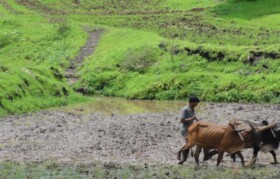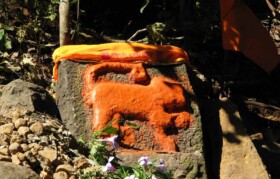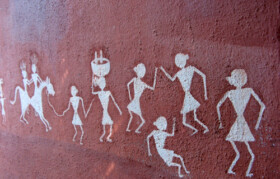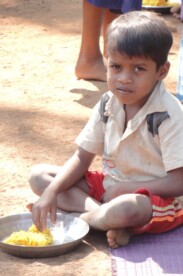Vikramgadh – Our Catchment Area

This post has already been read 1301 times!
Vikramgadh is a small tribal town, about 120km north of Mumbai. Despite proximity to financial capital of India, this place remains largely untouched by all the virtues and evils of urban life. The tribal lifestyle is very simple and in harmony with Mother Nature.The tribal culture is seeded by the belief that Mother Nature provides us with everything when we need.
While we do not have records of the roots of tribal culture in this area, some online references indicate that the tradition may be traced to as early as the tenth century AD, but might have originated sometime between 2500 BC and 3000 BC. What we know for sure though is that the place was originally known as Kudan, and was renamed later by a local ruler, Yashwant Mukane, in honor of his son Vikram. There also is a sister town Ashagadh, nearby in Dahanu area, which is named by the same ruler in honor of his daughter Asha. In 1999, Vikramgadh was constituted as a taluka-place (a headquarter town for local administration), with control on nearby villages like Dadade, Deharje, Sakhare, Vasuree and Alonde.
The tribal community in this area is traditionally engaged in farming. During the day, they would work on the farms in distant pockets of the jungle, and would return at night to their respective small colonies called Padas. A Pada is typically a small settlement comprising eighty to hundred houses which are typically occupied by families of like inheritance. The Padas are named after the surname of such families, for instance, Palav-Pada, Katar-Pada, Bhavar-Pada and so on. Lately, young population has moved into fishing and sand mining, but they primarily work as labors on daily wages and are poorly paid for.
It is customary for the families to have a pooja-place (holy area) in their houses where the whole family worships the Gods together. There are many Gods with unfamiliar names like Heerava, Himach, but Vaghoba is the most common deity. Each Pada has its own temple of Vaghoba. Palav-Pada, for example, has a really nice Vaghoba temple on a hill top surrounded by treasures of natural beauty.
On festive occasions like Holi (festival of colors), Deewali (festival of lights), and Sankrantee (thanksgiving for a good harvest) people come together and celebrate. If any family member is staying out-station, festival is the time for them to come back home and join the family in celebration. In fact, new crop like rice, beans, mango is taken off only on a particular day of the festival and not before. It is first offered to deities and then lunched together. Festivals, Harvests, Weddings are the times when men and women dance together. Tarpa is a traditional tribal dance, which indeed is an example of elegance and discipline.
While the modern society in India cries out for woman empowerment, it is interesting rather inspiring to acknowledge that the tribal community in this area follows Matriarchy. It is a society in which mothers have central role, moral authority, and control of property in a family. In marriages, the girls have freedom and privilege to choose the groom. It is the groom who offers gifts and cash to marry a girl. The groom also has to deposit some money with the village in which he is marrying. As a consequence, family violence, dowry deaths which are otherwise quite common in the rest of India are almost no-no here. Moreover, a woman can divorce her husband for a reason, and remarry. This is perfectly fine and is commonly acceptable in the society. In essence, the marriage institution is truly ideal. Isn’t it?
It is, however the paintings that brought this place the world-acclaim. What is now recognized as Warli paintings is the art that originated here and propagated over generations. Traditionally, the ritual paintings are done inside the house on the walls. These wall paintings are done only on special occasions such as weddings or harvests. For such paintings, it is only the white dye made up of rice paste that is used. The walls of hut, which are typically made up of tree-branches and red earth, provide the rusty red background.
The central theme in these paintings revolves around trees and animals, farming and hunting, festivals and dances. The painting techniques are extraordinarily rudimentary – A painting is done either by hand or with the help of a bamboo stick chewed at the end that serves as a paint-brush. A painting can be done on a wall or a floor or a utensil or a farm-equipment. The pictorial language has a very basic graphic vocabulary: a circle, a triangle, and a square. It is a crude style of painting lacking usual artistic activities, but nevertheless, it expresses the distinct lifestyle of the tribe and underscores their harmony with the nature.The art is passed on from generation to generation, primarily by the womenfolk, but lately, young girls do not necessarily know much about it. There are a few local artists who still strive to keep this art alive.
Although surrounded by the wealth of nature, farmers and workers here, both alike, are miserably poor. They are subject to inhuman hardship all throughout their lives as they engulf themselves in alcohol. It is the lack of education and health that we believe is the primary reason behind their sufferings.
Furthermore, children too hardly study after the fourth grade. It is therefore our sincere attempt to educate them, make them self-aware, and bring a sense of well-being among them – in all credible ways and by all suitable mean.
Suhrid Foundation has been associated with this area since July, 2012. After having interacted with thousands of people there during the medical camps, schools or otherwise, we can summarize the key health or socio-economic challenges as under.
- Early marriage of tribal girls at 13-14 years of age
- Sparing of no time gap between birth of successive children. By the age of 21, girl is already a mother of 3 or 4 children
- Newborn child is left under the care of older siblings, causing lapses in feeding schedule
- Lack of balanced diet at home
- Unhygienic living condition
- No potable water and sanitation
- Alcohol addiction among parents; often, no cooking is done
- Anganwadi supplies are inadequate for kids
- Unwillingness to stay in hospital for long periods for complete treatment. Reluctance to take medicines on regular basis





